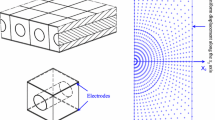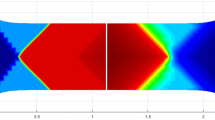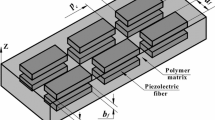Abstract
A two-dimensional generalized plane strain micromechanical model is developed to study the electro-elastic behavior of piezoelectric fiber-reinforced composite (PFRC) systems. The composite system consists of long parallel piezoelectric fibers with orthotropic and/or transversely isotropic properties and perfectly bounded to the isotropic matrix in a square array arrangement. In addition, the constituents are assumed to have both linear elastic and electrical behavior, whereas the matrix is piezoelectrically passive. The element-free Galerkin (EFG) method is employed to obtain the solution for the governing system of partial differential equations. The performance of the model is examined for both axial and transverse polarizations and various fiber cross sections. Comparison of the presented results with other techniques available in the literature reveals good agreement. It is demonstrated that the piezoelectric coefficient e 31 in the transverse polarization is considerably improved in comparison with the corresponding coefficient for pure piezoelectric material. Furthermore, results also show that elliptical fibers may enhance the electrical sensitivity of PFRCs for a specific direction, which is related to the elliptical fiber orientation, in both polarization directions.
Similar content being viewed by others
References
Safari A.: Development of piezoelectric composites for transducers. J. Phys. III 4, 1129–1149 (1994)
Jayendiran R., Arockiarajan A.: Non-linear electromechanical response of 1–3 type piezocomposites. Int. J. Solids Struct. 50, 2259–2270 (2013)
Li L., Zhang S., Xu Z., Wen F., Geng X., Lee H.J., Shrout T.R.: 1–3 piezoelectric composites for high-temperature transducer applications. J. Phys. D: Appl. Phys. 46, 165306 (2013)
Bravo-Castillero J., Guinovart-Dıaz R., Sabina F.J., Rodrıguez-Ramos R.: Closed-form expressions for the effective coefficients of a fiber-reinforced composite with transversely isotropic constituents–II. piezoelectric and square symmetry. Mech. Mater. 33, 237–248 (2001)
Tan P., Tong L.: Modeling for the electro-magneto-thermo-elastic properties of piezoelectric-magnetic fiber reinforced composites. Compos. A: Appl. Sci. Manuf. 33, 631–645 (2002)
Mallik N., Ray M.C.: Effective coefficients of piezoelectric fiber-reinforced composites. AIAA J. 41, 704–710 (2003)
Odegard G.M.: Constitutive modeling of piezoelectric polymer composites. Acta Mater. 52, 5315–5330 (2004)
Berger H., Kari S., Gabbert U., Rodriguez-Ramos R., Guinovart R., Otero J.A., Bravo-Castillero J.: An analytical and numerical approach for calculating effective material coefficients of piezoelectric fiber composites. Int. J. Solids Struct. 42, 5692–5714 (2005)
Ray M.C.: Micromechanics of piezoelectric composites with improved effective piezoelectric constant. Int. J. Mech. Mater. Des. 3, 361–371 (2006)
Della C.N., Shu D.: On the performance of 1–3 piezoelectric composites with a passive and active matrix. Sens. Actuators A: Phys. 140, 200–206 (2007)
Kar-Gupta R., Venkatesh T.A.: Electromechanical response of 1–3 piezoelectric composites: an analytical model. Acta Mater. 55, 1093–1108 (2007)
Kumar A., Chakraborty D.: Effective properties of thermo-electro-mechanically coupled piezoelectric fiber reinforced composites. Mater. Des. 30, 1216–1222 (2009)
Sakthivel M., Arockiarajan A.: An analytical model for predicting thermo-electro-mechanical response of 1–3 piezoelectric composites. Comput. Mater. Sci. 48, 759–767 (2010)
Guinovart-Díaz R., Yan P., Rodríguez-Ramos R., López-Realpozo J.C., Jiang C.P., Bravo-Castillero J., Sabina F.J.: Effective properties of piezoelectric composites with parallelogram periodic cells. Int. J. Eng. Sci. 53, 58–66 (2012)
López-López E., Sabina F.J., Guinovart-Díaz R., Bravo-Castillero J., Rodríguez-Ramos R.: Effective permittivity of a fiber-reinforced composite with transversely isotropic constituents. J. Electrost. 71, 791–800 (2013)
Lin C.-H., Muliana A.: Micromechanics models for the effective nonlinear electro-mechanical responses of piezoelectric composites. Acta Mech. 224, 1471–1492 (2013)
Kar-Gupta R., Venkatesh T.A.: Electromechanical response of 1–3 piezoelectric composites: effect of poling characteristics. J. Appl. Phys. 98, 054102 (2005)
Kar-Gupta R., Marcheselli C., Venkatesh T.A.: Electromechanical response of 1–3 piezoelectric composites: effect of fiber shape. J. Appl. Phys. 104, 024105 (2008)
Dai Q., Ng K.: Investigation of electromechanical properties of piezoelectric structural fiber composites with micromechanics analysis and finite element modeling. Mech. Mater. 53, 29–46 (2012)
Brockmann T.H.: Theory of Adaptive Fiber Composites: From Piezoelectric Material Behavior to Dynamics of Rotating Structures, vol. 161. Springer, Heidelberg (2009)
Most T., Bucher C.: New concepts for moving least squares: an interpolating non-singular weighting function and weighted nodal least squares. Eng. Anal. Bound. Elem. 32, 461–470 (2008)
Liu G.-R., Gu Y.-T.: An Introduction to Meshfree Methods and Their Programming. Springer, Heidelberg (2005)
Dang T.D., Sankar B.V.: Meshless local Petrov–Galerkin formulation for problems in composite micromechanics. AIAA J. 45, 912–921 (2007)
Ahmadi I., Aghdam M.M.: Micromechanics of fibrous composites subjected to combined shear and thermal loading using a truly meshless method. Comput. Mech. 46, 387–398 (2010)
Ahmadi I., Aghdam M.M.: A truly generalized plane strain meshless method for combined normal and shear loading of fibrous composites. Eng. Anal. Bound. Elem. 35, 395–403 (2011)
Belytschko T., Lu Y.Y., Gu L.: Element-free Galerkin methods. Int. J. Numer. Methods Eng. 37, 229–256 (1994)
Dolbow J., Belytschko T.: An introduction to programming the meshless element free Galerkin method. Arch. Comput. Methods Eng. 5, 207–241 (1998)
Aghdam M.M., Pavier M.J., Smith D.J.: Micro-mechanics of off-axis loading of metal matrix composites using finite element analysis. Int. J. Solids Struct. 38, 3905–3925 (2001)
Fernández-Méndez S., Huerta A.: Imposing essential boundary conditions in mesh-free methods. Comput. Methods Appl. Mech. Eng. 193, 1257–1275 (2004)
Zhu T., Atluri S.N.: A modified collocation method and a penalty formulation for enforcing the essential boundary conditions in the element free galerkin method. Comput. Mech. 21, 211–222 (1998)
Tang T., Yu W.: Variational asymptotic micromechanics modeling of heterogeneous piezoelectric materials. Mech. Mater. 40, 812–824 (2008)
Liu G.-R.: Meshfree Methods: Moving Beyond the Finite Element Method. CRC Press, Boca Raton (2009)
Amdahl, G.M.: Validity of the single processor approach to achieving large scale computing capabilities. In: Proceedings of the April 18–20, 1967, Spring Joint Computer Conference, pp. 483–485. ACM (1967)
Meitzler, A., Tiersten, H.F., Warner, A.W., Berlincourt, D., Couqin, G.A., Welsh III, F.S.: IEEE Standard on Piezoelectricity. ANSI/IEEE Std 176–1987 (1988). doi:10.1109/IEEESTD.1988.79638
Author information
Authors and Affiliations
Corresponding author
Rights and permissions
About this article
Cite this article
Eynbeygi, M., Aghdam, M.M. A micromechanical study on the electro-elastic behavior of piezoelectric fiber-reinforced composites using the element-free Galerkin method. Acta Mech 226, 3177–3194 (2015). https://doi.org/10.1007/s00707-015-1371-x
Received:
Published:
Issue Date:
DOI: https://doi.org/10.1007/s00707-015-1371-x




